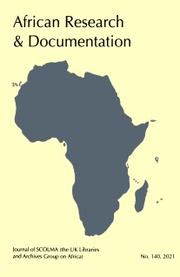Article contents
Missionary Archives on Africa: A Fine Grained Understanding
Published online by Cambridge University Press: 25 April 2022
Extract
Much historical evidence for the activities and reception of early African converts and indigenous Christian movements is found in the vast corpus of documentation produced and preserved by western missionary societies in Europe. In order to understand the evidence, historians, archivists and librarians do well to comprehend the nature of the sources that they use. In recent years there has been greater attention to archives as collections in order to appreciate the rationale behind historical events, personages and thought. This short essay gives some background to these historiographical issues before examining the outputs of the Church Missionary Society (CMS) missionaries in order to provide a case-study that may be a useful comparator for similar collections. My reflections emerge from my own research into socio-religious change in East Africa through a biography of a prominent Ugandan clergyman, Apolo Kivebulaya, who worked alongside CMS missionaries from the British Isles.
- Type
- Other Articles
- Information
- Copyright
- Copyright © African Research & Documentation 2019
References
- 3
- Cited by


